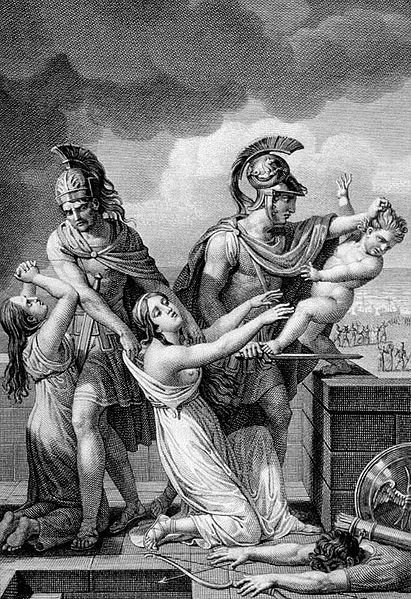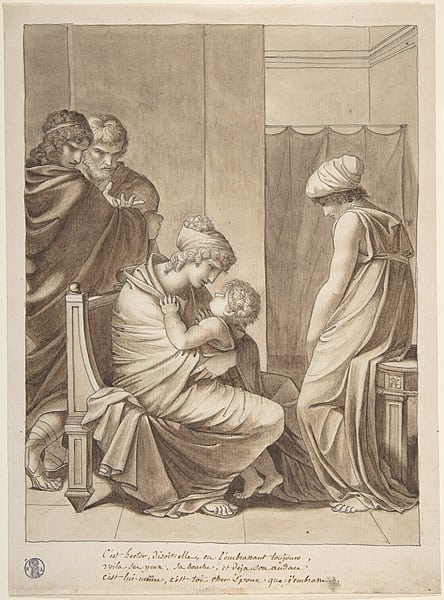In the vast tapestry of Greek mythology, some figures shine brightly, while others cast a more subtle glow. Among the latter is Astyanax, also known as Scamandrius, the young prince of Troy. His story, though brief, is one of profound tragedy and serves as a poignant reminder of the human cost of war.
Astyanax Key Facts
| Keyword | Fact |
| Parents | Hector and Andromache |
| Partners | None |
| Siblings | None |
| Offspring | None |
| Other names | Scamandrius |
| Roman name | Astyanax |
| Best Known Myth | Death during the fall of Troy |
Name and Etymology
Astyanax, a name that resonates with the walls of Troy and the echoes of its tragic fall. While he was originally named Scamandrius after the River Scamander, near Troy, the people of the city affectionately nicknamed him Astyanax, which translates to “lord of the city” or “prince of the city.” This endearing title was not just a casual moniker; it was a testament to his lineage and the significant role he was expected to play as the son of Hector, the crown prince and mightiest warrior of Troy.
The name Astyanax, over time, became more popular and synonymous with the young prince’s identity, overshadowing his birth name. In Roman tales, he retains the name Astyanax, emphasizing the universal appeal and resonance of his tragic story. Various epithets and alternative names aren’t as prevalent for Scamandrius, but his two primary names, especially Astyanax, are deeply rooted in the hopes and heartbreaks of Troy.
Astyanax’s Roman counterpart doesn’t deviate much from his Greek origins. The Romans, known for adapting Greek myths and characters, chose to keep his story and name intact. This decision underscores the profound impact of his narrative, resonating across cultures and time.

Astyanax’s Family and Relationships
Born to Hector, The Noble Trojan Prince of Greek Mythology, the crown prince and mightiest warrior of Troy, and Andromache, the devoted wife and mother, Astyanax was the embodiment of Troy’s future hopes. As the grandson of King Priam and potential heir to the Trojan throne, much was expected of him. His birth was not just a personal joy for Hector and Andromache but symbolized hope for the entire city during the tumultuous Trojan War.
However, his childhood was overshadowed by the looming threat of the Greek forces. Special events of his early life are scarce, as his narrative is tragically cut short by the war’s conclusion. The weight of his potential role in Troy’s future, combined with his tragic fate, makes his story all the more poignant.
While tales of love interests and friendships are common for many figures in Greek mythology, Scamandrius’s youth precluded such narratives. His story is less about personal relationships and more a symbol of the devastating consequences of war on the innocent and the heavy burden of expectations placed on the young shoulders of a prince.
The Fall of Troy and Astyanax’s Tragic Fate
Astyanax’s story is inextricably linked to the fall of Troy, a city that once stood proud and unyielding. As the Greeks finally found their way into the city through the cunning ruse of the Trojan Horse, chaos and destruction ensued. Amidst the burning city and the cries of its inhabitants, the fate of young Scamandrius became a focal point of the tragedy.
In the most widely accepted version of the myth, as the Greeks stormed the city, they recognized the potential threat posed by Astyanax. Being the son of Hector, the crown prince, he was the heir to the Trojan throne. The Greeks feared that if he were allowed to live, he might one day seek vengeance and attempt to rebuild Troy. In a heart-wrenching scene, Neoptolemus (Pyrrhus), Fiery Successor of Achilles, the son of Achilles, The Mightiest Champion of The Trojan War, took the young prince and threw him from the city walls, ending his life. This act was not just a strategic move but also a symbolic one, signifying the complete annihilation of Troy’s royal lineage and the extinguishing of its future hopes.
Alternative accounts
However, like many myths, there are alternative versions and interpretations. Some accounts suggest it was not Neoptolemus but Odysseus, The Cunning Hero Of The Trojan War who proposed the idea of killing Astyanax, fearing the boy’s potential to avenge his father’s death. In another version, it was the collective decision of the Greek leaders, emphasizing the perceived threat the child posed to their victory.
Regardless of the variations in the tale, the core remains the same: Astyanax’s tragic end is a poignant reminder of the human cost of war, the loss of innocence, and the cruel twists of fate that can befall even the youngest and most vulnerable.
Depiction And Characteristics
Scamandrius’s appearance in myths is that of a young child, often depicted in the arms of his mother, Andromache, or with his father, Hector. There aren’t specific symbols or creatures directly associated with him. However, his portrayal is always a poignant reminder of the war’s collateral damage.
His personality, as gleaned from the myths, is that of an innocent child, unaware of the grander schemes at play. The Ancient Greeks viewed him as a tragic figure, an embodiment of lost potential and the profound cost of conflict.
Representations Of Astyanax In Art
Art, with its timeless nature, has immortalized the tale of Astyanax, capturing the raw emotions and the profound tragedy of his story. One of the most poignant depictions is found on ancient Greek vases, where he’s shown in his mother’s arms as Hector bids them farewell, a moment that encapsulates the looming dread of war and separation.
Another moving representation is in Euripides’ play “The Trojan Women,” where the women of Troy mourn Astyanax’s tragic fate. Their lamentations and grief serve as a powerful commentary on the human cost of war.
Additionally, in the world of sculpture, there’s a notable relief from the Roman period that depicts the heart-wrenching scene of Andromache holding her son for the last time before his tragic death. This piece, found in the collections of several European museums, captures the raw emotion and the profound sorrow of a mother’s final moments with her child.

Mentions in Ancient Texts
Homer – “Iliad”
Time Written: 8th century BC
About the Author: Homer, the legendary ancient Greek poet, is best known for his epic poems “Iliad” and “Odyssey.” While much about his life remains a mystery, his works have profoundly influenced Western literature.
In the “Iliad,” Astyanax’s story is touched upon with tenderness. In one particularly touching scene, Hector tries to embrace his son, but the child, frightened by the sight of his father’s helmet, recoils. This fleeting moment paints a vivid picture of the war’s personal toll and the juxtaposition of a warrior’s life with his role as a father.
Euripides – “The Trojan Women”
Time Written: 415 BC
About the Author: Euripides was one of the great tragedians of classical Athens. Known for his strong female characters and exploration of societal issues, his plays remain relevant even today.
In “The Trojan Women,” Euripides delves into the aftermath of Troy’s fall, focusing on the plight of its women. Astyanax’s tragic fate is central to the narrative, with the women of Troy lamenting over the child’s cruel end. A quote from the play captures the essence of his tragedy: “O child, Scamandrius, who on your father’s knees once sat, a prince, and played with the scepter of Troy, which you held in your hands…”
Quintus of Smyrna – “Posthomerica”
Time Written: 4th century AD
About the Author: Quintus of Smyrna, a later Greek epic poet, is known for his work “Posthomerica,” which fills the narrative gap between Homer’s “Iliad” and “Odyssey.”
In “Posthomerica,” Quintus offers a detailed account of the events following Hector’s death, leading up to the fall of Troy. Astyanax’s tragic fate is recounted with a fresh perspective, providing additional layers to the narrative and emphasizing the profound sorrow and loss experienced by the Trojan survivors.
Frequently Asked Questions
Astyanax, also known as Scamandrius, was the son of Hector and Andromache.
The name Scamandrius is derived from the River Scamander, near Troy.
During the fall of Troy, Neoptolemus threw him off the city walls, fearing he might rebuild Troy in the future.
Yes, he plays a significant role in Euripides’ “The Trojan Women,” which delves into the aftermath of Troy’s fall.
While there aren’t specific symbols tied to him, he’s often depicted with his parents, especially in scenes of farewell.
Scamandrius’s tale underscores the profound human cost of war, especially on the innocent.
Featured Image Credit: Benjamin West, Public domain, via Wikimedia Commons
